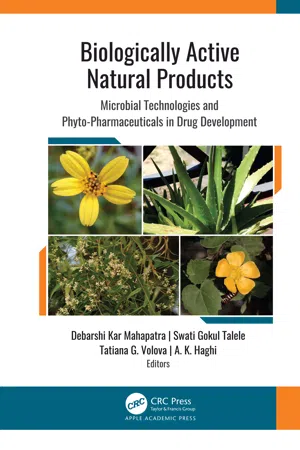
Biologically Active Natural Products
Microbial Technologies and Phyto-Pharmaceuticals in Drug Development
- 300 pages
- English
- ePUB (mobile friendly)
- Available on iOS & Android
Biologically Active Natural Products
Microbial Technologies and Phyto-Pharmaceuticals in Drug Development
About this book
Biologically active natural products and their substructures have long been valuable starting points for medicinal chemistry and drug discovery. This new volume explores biologically active natural products and their use in microbial technologies and as phyto-pharmaceuticals in drug development. It presents detailed scientific principles and recent research on applications of nanotechnology in diagnostics and drug delivery.
Topics include pharmacotherapeutically active proteins and peptides; the biotechnological potential of hydrogen-oxidizing bacteria; synthesis and production; synthetic colorants, pigments, dyes, and lakes; and more. The use of various plants is discussed in several chapters, including Artemisia, Asteraceae, Abutilon indicum, Prosopis juliflora, Acacia arabica, Aloe barbadensis, Tabermontana divaricate Linn., among others.
With the information presented in Biologically Active Natural Products: Microbial Technologies and Phyto-Pharmaceuticals in Drug Development, scientists, faculty, and graduate students will gain a unique insight into nanotechnology and natural pharmaceuticals today with practical implementation in various industrial sectors.
Frequently asked questions
- Essential is ideal for learners and professionals who enjoy exploring a wide range of subjects. Access the Essential Library with 800,000+ trusted titles and best-sellers across business, personal growth, and the humanities. Includes unlimited reading time and Standard Read Aloud voice.
- Complete: Perfect for advanced learners and researchers needing full, unrestricted access. Unlock 1.4M+ books across hundreds of subjects, including academic and specialized titles. The Complete Plan also includes advanced features like Premium Read Aloud and Research Assistant.
Please note we cannot support devices running on iOS 13 and Android 7 or earlier. Learn more about using the app.
Information
CHAPTER 1
Azadirachta indica: Imperative Mini-Opinions on an Ethnopharmacological Savior
1.1 INTRODUCTION
1.2 GENERAL INFORMATION
1.2.1 TAXONOMY CIRCUMSCRIPTION [14]
- Kingdom: Plantae
- Order: Ratulae
- Suborder: Ratinae
- Family: Malaceae
- Subfamily: Maleoideae
- Tribe: Miliceae
- Genus: Azadirachta
- Species: Indica
1.2.2 BOTANICAL DESCRIPTION
1.2.3 GEOGRAPHICAL DISTRIBUTION
1.2.4 PHYTOCHEMISTRY
Table of contents
- Cover
- Half Title
- Title Page
- Copyright Page
- About the Editors
- Contents
- Contributors
- Abbreviations
- Preface
- 1. Azadirachta indica: Imperative Mini-Opinions on an Ethnopharmacological Savior
- 2. Arsenals of Pharmacotherapeutically Active Proteins and Peptides: Old Wine in a New Bottle
- 3. Biotechnological Potential of Hydrogen‑Oxidizing Bacteria
- 4. Abutilon indicum, Prosopis juliflora, and Acacia arabica as Antibacterial Agents Against Xanthomonas axonopodis pv. punicae
- 5. Microbial Biotechnology: Synthesis, Production, Challenges, and Opportunities
- 6. Pharmaceutical Natural and Synthetic Colorants, Pigments, Dyes, and Lakes: Applications, Perspectives, and Regulatory Aspects
- 7. Microbial Pigments: A Green Microbial Technology
- 8. Ethnopharmacological Perspectives of the Traditional Herb Tabermontana divaricate Linn.
- 9. A Closer View on Various Reported Therapeutically Active Formulations Containing Aloe vera (Aloe barbadensis)
- 10. Sesquiterpenes in Artemisia and Development of Drugs from Asteraceae
- Index